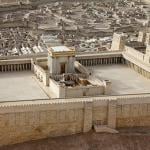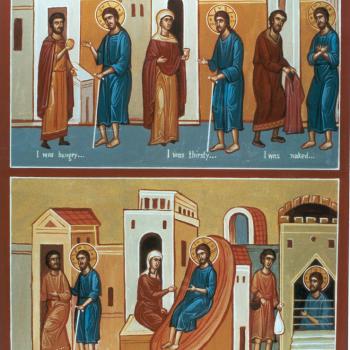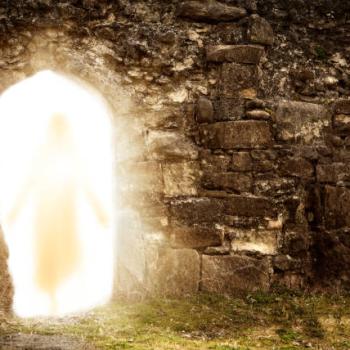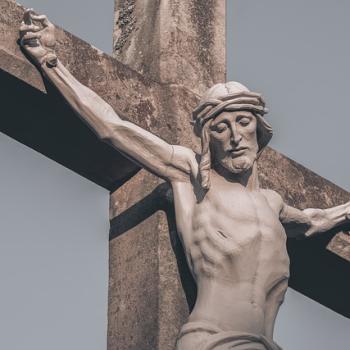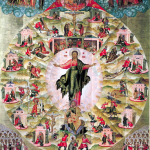
It’s Tuesday in the first Holy Week. A little band is walking with Jesus up to Jerusalem again, quite a bit more somber than yesterday. The disciples are thinking how their leader almost got them all arrested yesterday. And what was the point? They come upon a dead fig tree, which yesterday was alive.
Jesus had cursed it for no good reason, and today it’s all shriveled up, never to bear fruit again. Well, that’s only for Mark’s readers because it didn’t really happen. But these readers are familiar with Mark’s sandwich technique. In this case, a real event, Jesus’ protest demonstration in the Temple (the lettuce and mayo), is surrounded by two parts of a story Mark made-up story (the two slices of bread). The literary structure shows the event’s true meaning. The dead fig tree tells the reader that Jesus intended his action in the Temple to symbolize the Temple’s destruction. The disciples don’t understand this yet, but today they’ll hear enough about destruction from Jesus’ lips to start them wondering at least.
Contentious encounters
Two times today Jesus indulges in some violent imagery. First it’s: “Amen, I say to you, whoever says to this mountain, ‘Be lifted up and thrown into the sea,’ and does not doubt in his heart but believes that what he says will happen, it shall be done for him.” “This mountain” happens to be the mountain up which the group is ascending, on top of which the Temple stands.
The second time comes after they have reached Jerusalem and the Temple area. Jesus tells a story about wicked tenants of a vineyard. They abuse and kill messengers from the owner and even kill the owner’s son rather than pay the owner the portion of produce due to him. The priests, scribes, and elders hearing the parable understand that the tenants represent them and the vineyard is the people of Israel in their care. The story says they’re failing terribly in their responsibility. But they’re afraid of the crowd so they don’t make a move against Jesus even when at the end of the story the owner kills those wicked tenants.
Jesus is only getting started. He has several more contentious encounters with Temple figures this day. One starts with a question about paying taxes to the emperor. Jesus’ opponents expect to get him in trouble, either with the Romans or the crowds, depending on whether he endorses or opposes paying the tax. Jesus masterfully ends the confrontation with the memorable “Repay to Caesar what belongs to Caesar and to God what belongs to God.” Sadly modern interpreters remember the saying as an early and completely anachronistic version of separation of church and state. But Jesus wasn’t endorsing keeping the two parties in their separate spheres of authority and paying both. Rich tax payers and poor alike in that place and time, knew what belonged to Caesar – nothing. Everything belongs to God.
Jesus didn’t exactly say, “Don’t pay the tax,” so at his trial that charge couldn’t quite stick. He did manage to entertain the crowd and stick it to his well-healed opponents.
The dead fig tree and what must happen to the Temple
So far and through a few other clashes, Jesus is pretty even-tempered compared to yesterday. But his anger rises again near the end of the day. He’s sitting down opposite the treasury and watching as people put in their contributions. Rich people are putting in large amounts that they can easily afford. But a poor woman puts in two small coins worth a few cents in today’s money. Jesus rages (as I imagine it), “Amen, I say to you, this poor widow put in more than all the others. They have all given out of their surplus, but she has given all she had, her whole livelihood.” Was Jesus commending the widow and others like her for their sacrificial giving? Not at all? He is enraged that the Temple establishment has gotten so greedy as to accept any money at all from disadvantaged people like the poor widow.
Jesus is angry also at his disciples for even now not understanding what Mark symbolized by a dead fig tree. On their way out of the Temple area to go back to Bethany for the night, one of them turns around and marvels, “Look, Teacher. What stones and what buildings!” Jesus thunders back, “Do you see these great buildings! There will not be one stone left upon another than will not be thrown down.” Will they ever get it? Will we?
(This story about a dead fig tree and Tuesday of the first Holy Week is mostly collected from other things I have written on Jesus’ advocacy for God’s justice within the kingdoms of this world. If you find this helpful, you can read lots more under the title “The Worldly Spirituality of the Gospel of Mark.”)


